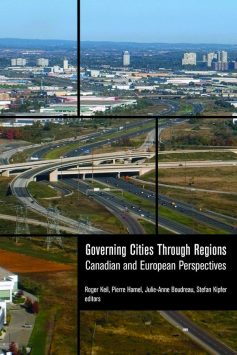For anyone who’s driven the Trans-Canada Highway from Winnipeg to Toronto by the north shore of Lake Superior, where your only companions are 2,000 kilometres of rocks and trees, an arresting thought: “Canada and Europe rank among the most urbanized areas in the world.”
So Governing Cities Through Regions draws readers into a compelling conflict that’s escaped the attention of most pundits and politicians. “There are now increasing tensions between the demands of more complex urban cities and economies, and the political constitutions and institutions of national affairs,” editors write.
Canada has no Minister of Urban Development. Alberta in 1994 shut down its regional planning commissions as an austerity measure. Planning was strictly voluntary. As Prof. Pierre Hamel of the Université de Montréal puts it, “This standpoint is anything but awkward to observers of the urban scene, as Canadians are increasingly living in cities and have never been more concentrated in city-regions.”
Governing Cities Through Regions spies the land. In Vancouver, municipal authorities run their own railway, SkyTrain, and their own navy, the SeaBus ferry system. The Greater Vancouver Regional Board manages its own dam and water reservoirs and a bureaucracy of 1,300.
In Toronto, the Community Housing Corporation manages $6 billion in property with 164,000 tenants, a bigger constituency than the City of Moncton. In Markham, Ont., where the city did not even exist in 1969, the district is home to 332,000 people and 400 corporate head offices.
“Institutional reform of metropolitan areas has remained elusive,” note editors of Governing Cities Through Regions. “In spite of various national and regional state efforts since the 1960s, most major North American and European metropolitan areas by the end of the twentieth century did not have true metropolitan governments.”
Editors compare Toronto and Montréal, Paris and Frankfurt, Winnipeg and another “typical slow-growth city”, post-Soviet Katowice, Poland. The contrasts are not flattering.
Montréal has the highest rate of low-income households in any major Canadian city, 29 percent. Winnipeg estimates 20 percent of inner-city streets are in such poor shape they must be rebuilt. Toronto’s dysfunction is legendary.
“One of the arguments of why regions matter is because the image that somehow the region consists of Toronto, which has pockets of poverty surrounded by a whole bunch of suburbs which are relatively middle class, is in fact not true,” a housing official tells editors. “The issues and needs are very similar across the region.”
Governing Cities Through Regions examines the problem, and identifies solutions. We are so much more than 2,000 kilometres of rocks and trees.
By Holly Doan
Governing Cities Through Regions: Canadian and European Perspectives, edited by Roger Keil, Pierre Hamel, Julie-Anne Boudreau and Stefan Kipfer; Wilfrid Laurier University Press; 416 pages; ISBN 9781-77112-771; $39.99






